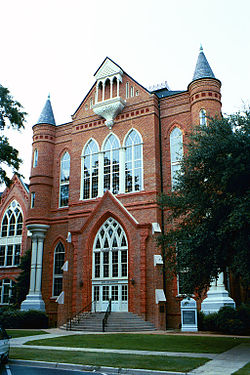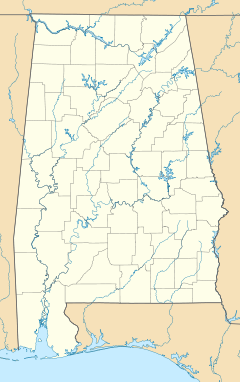- Gorgas–Manly Historic District
-
Gorgas-Manly Historic District
 Clark Hall
Clark HallLocation: University of Alabama campus
Tuscaloosa, AlabamaCoordinates: 33°12′44″N 87°32′45″W / 33.21222°N 87.54583°WCoordinates: 33°12′44″N 87°32′45″W / 33.21222°N 87.54583°W Area: 12 acres (4.9 ha) Built: 1829-88 Architect: Multiple Architectural style: Federal, Greek Revival, Gothic Revival Governing body: State NRHP Reference#: 71000108[1] Added to NRHP: July 14, 1971 The Gorgas-Manly Historic District is a historic district that includes 12 acres (4.9 ha) and eight buildings on the campus of the University of Alabama in Tuscaloosa, Alabama.[1] The buildings represent the university campus as it existed from the establishment of the institution through to the late 19th century. Two buildings included in the district, Gorgas House and the Little Round House, are among only seven structures to have survived the burning of the campus by the Union Army, under the command of Brigadier General John T. Croxton, on April 4, 1865.[2][3] The other survivors were the President's Mansion and the Old Observatory, plus a few faculty residences.[4][5]
Woods Hall was the first building constructed following the American Civil War. The remaining five buildings, Clark, Manly, Garland, Tuomey and Barnard Halls, represent campus construction during the economic recovery that followed the end of the Reconstruction era.[6]
The construction of Manly, Clark, Garland, and other buildings was financed by the sale of a large portion of 46,800 acres (189 km2) of land given by the United States Congress to the University as repayment "for the fiery ruin brought by Federal troops in 1865."[7]
Contents
The district
See also: University of Alabama QuadGorgas House
An early example of the Greek Revival style in Alabama, the Gorgas House was the first building built on the campus of the university. Designed by William Nichols, designer of the original campus and Tuscaloosa's Old Alabama State Capitol, it was completed in 1829, prior to the opening of the campus. The main facade, minus the portico, reflects the continuing influence of the Federal style. Initially used as a guest house for visitors and professors and as a dining hall for students, it was converted to use as a faculty residence in the late 1840s. The house gained its current name from Josiah Gorgas, the seventh University of Alabama president. Ill health forced him to resign as president and the trustees gave him the house to retire to. The Alabama legislature designated the house as a memorial to the Gorgas family in 1944 and today it is including among the University of Alabama Museums.[8][9][10]
Little Round House
This small octagonal building with crenelations originally served as the guard house of the university. It was completed in 1860 and reflected the conversion of the university into a military campus. The conversion occurred on February 23, 1860, by an act of the Alabama legislature. As tensions between North and South escalated, the request for the transition came from the university president of the time, Landon Garland.[3] Ironically, the Little Round House, despite its military associations, was one of the few structures that remained after Federal troops burned the campus. When the university reopened its doors in 1871 the building was used as a physician's office. A few years later, while in a deteriorated condition, the building was considered for demolition. It was saved by the university trustees and converted into a records repository. It became known as Jasons Shrine during the 1930s, while being used by the Jasons, a men’s honor society. 1990 saw the structure converted into a memorial for all of the honor societies.[9][10]
Woods Hall
Woods Hall was the first new building on campus following the Civil War. Constructed from 1867 to 1868, the four-story brick structure was built with a Gothic Revival arcade on the ground floor, end facades in the Gothic Revival style with a crenelated roof, and cast iron galleries on the central upper floors. Initially known simply as "the barracks," it was used as a dormitory. It also had a dining hall and classrooms on the ground floor. It remained a dormitory until 1961, when it was converted for use by the Department of Art and Art History.[9][10]
The area between Woods Hall on the one side and Woods, Clark, and Manly on the other side is known as Woods Quad.
Clark Hall
Built in 1884, the Gothic Revival-style Clark Hall was constructed on the site of the old Lyceum, destroyed during the Civil War. Clark was originally designed as an all-purpose building with a library, reading rooms, chapel, and a large public meeting room,[9][10] which served as "the great public hall of the University."[11] By 1910 the building was beginning to deteriorate and the brick walls were near collapse by the late 1940s, due to the heavy roof. The hall was saved by the erection of an interior steel frame within the building, preserving it for future generations. The building was restored again in the 1980s. It was named for Willis G. Clark, a university trustee.[9][10]
Clark Hall contains the main office space for the College of Arts and Sciences, as well as a dance studio (currently overseen by Cornelius Carter).
Manly Hall
Manly Hall is a 3 1⁄2-story Gothic Revival structure in red brick. Similar in design to Clark Hall, it was finished in 1885. Originally built as a dormitory, it now houses the Department of Religious Studies, the Department of Women's Studies, offices of the English department, and the office of the literary magazine Black Warrior Review. It was named in honor of Basil Manly, the second university president.[9][10]
Garland Hall
The three-story Garland Hall is another Gothic Revival–style building on campus, built in 1887[12] to house a dormitory and the first incarnation of the Alabama Museum of Natural History.[9][10] It is the "counterpart" of Manly Hall,[13] and today houses the Sarah Moody Gallery of Art.[14]
Tuomey Hall
The 2 1⁄2-story Tuomey Hall, now known as the Blount Undergraduate Initiative Tuomey Academic House, was completed in 1889. Built as a laboratory for the Department of Chemistry, it was named in honor of Michael Tuomey, state geologist and professor.[9][10] Toumey hall was previously the home of Army ROTC at the University of Alabama.
Barnard Hall
The 2 1⁄2-story Barnard Hall, now known as Oliver-Barnard Hall, was completed in 1889. Built as a laboratory and gymnasium, it now houses offices and classrooms for the College of Arts and Sciences. It was named for scientist and professor, Frederick A. P. Barnard. It was rededicated as Oliver-Barnard Hall in 2000 in honor of John T. Oliver Jr., trustee emeritus.[9][10] Barnard Hall was previously the home of Air Force ROTC at the University of Alabama.
See also
References
- ^ a b "National Register Information System". National Register of Historic Places. National Park Service. 2009-03-13. http://nrhp.focus.nps.gov/natreg/docs/All_Data.html.
- ^ "History of UA:Historical Timeline". University of Alabama. http://www.ua.edu/history.html. Retrieved 2009-12-02.
- ^ a b Center, Clark E. (1990). "The Burning of the University of Alabama". Alabama Heritage Spring 1990 (16): 30–45. http://www.alabamaheritage.com/vault/UAburning.htm.
- ^ "The Battle of Tuscaloosa". War of the Rebellion: the American Civil War. http://www.mycivilwar.com/battles/650404.htm. Retrieved 2009-12-02.
- ^ "University of Alabama (UA)". Encyclopedia of Alabama. http://encyclopediaofalabama.org/face/Article.jsp?id=h-1678. Retrieved 2009-12-05.
- ^ "National Register Information System". National Register of Historic Places. National Park Service. 2009-05-30. http://nrhp.focus.nps.gov/natreg/docs/All_Data.html.
- ^ Campbell Du Bose, Joel (1901). Sketches of Alabama history. Eldredge & Bro.. p. 158. http://books.google.com/books?id=FzrXHFb5LmcC&pg=PA158.
- ^ Mellown, Robert O. (2005). "Variations on a Capitol Plan". Alabama Heritage Summer 2005 (77). http://findarticles.com/p/articles/mi_qa4113/is_200507/ai_n14779001/?tag=content;col1.
- ^ a b c d e f g h i Mellown, Robert Oliver (1988). The University of Alabama: a guide to the campus. Tuscaloosa, Alabama: University of Alabama Press.
- ^ a b c d e f g h i Wolfe, Suzanne Rau (1983). The University of Alabama, a pictorial history. University, Alabama: University of Alabama Press.
- ^ United States Bureau of Education (1889). Circular of information of the Bureau of Education, Volume 10. United States Government Printing Office. p. 111. http://books.google.com/books?id=cz8XAAAAYAAJ&pg=RA1-PA111.
- ^ United States Bureau of Education (1889). Circular of information of the Bureau of Education, Volume 10. United States Government Printing Office. p. 110. http://books.google.com/books?id=cz8XAAAAYAAJ&pg=RA1-PA110&dq=%22Manly+Hall%22+alabama&lr=&client=firefox-a#v=onepage&q=%22Manly%20Hall%22%20alabama&f=false.
- ^ Berney, Saffold (1892). Hand-book of Alabama: A complete index to the state, with map. Roberts & Son. p. 190. http://books.google.com/books?id=WDV_rsw3i2YC&pg=PA190.
- ^ Bursch, Karissa (2008-10-15). "Millions of dollars worth of art given to the University". Crimson White. http://www.cw.ua.edu/millions-of-dollars-worth-of-art-given-to-the-university-1.823259. Retrieved 2009-12-06.[dead link]
U.S. National Register of Historic Places Topics Lists by states Alabama • Alaska • Arizona • Arkansas • California • Colorado • Connecticut • Delaware • Florida • Georgia • Hawaii • Idaho • Illinois • Indiana • Iowa • Kansas • Kentucky • Louisiana • Maine • Maryland • Massachusetts • Michigan • Minnesota • Mississippi • Missouri • Montana • Nebraska • Nevada • New Hampshire • New Jersey • New Mexico • New York • North Carolina • North Dakota • Ohio • Oklahoma • Oregon • Pennsylvania • Rhode Island • South Carolina • South Dakota • Tennessee • Texas • Utah • Vermont • Virginia • Washington • West Virginia • Wisconsin • WyomingLists by territories Lists by associated states Other  Category:National Register of Historic Places •
Category:National Register of Historic Places •  Portal:National Register of Historic Places
Portal:National Register of Historic PlacesThe University of Alabama Schools and colleges College of Arts and Sciences · Culverhouse College of Commerce and Business Administration · College of Communication and Information Sciences · College of Education · College of Engineering · Honors College · College of Human Environmental Sciences · Capstone College of Nursing · School of Social Work · School of Law · College of Community Health Sciences · College of Continuing StudiesPeople Julia Tutwiler · Amelia Gayle Gorgas · George Wallace · George H. Denny · Robert E. Witt · Alabama peoplePlaces Alabama Museum of Natural History · Amelia Gayle Gorgas Library · Denny Chimes · Ferguson Center · Foster Auditorium · Gorgas House · Little Round House · Maxwell Hall (Old Observatory) · Moundville Archaeological Park · Paul W. Bryant Museum · President's Mansion · The Quad · Strode House · University of Alabama ArboretumAthletics Programs: Football · Men's basketball · Baseball · Gymnastics · Softball · Women's basketball · Golf · Volleyball · Tennis · Soccer · Track & field · Swimming & diving · Rowing · Cross country
Current coaches: Mitch Gaspard (Baseball) · Anthony Grant (Men's basketball) · Wendell Hudson (Women's basketball) · Patrick Murphy (Softball) · Sarah Patterson (Gymnastics) · Nick Saban (Football)
Facilities: Bryant–Denny Stadium · Coleman Coliseum · Foster Auditorium · Rhoads Stadium · Sewell–Thomas Stadium · Alabama Soccer StadiumBroadcasting Organizations and traditions Affiliations Endowment: $515.2 million · Students: 30,252 · Faculty: 1,622 Categories:- Historic districts in Alabama
- Federal architecture in Alabama
- Greek Revival architecture in Alabama
- Gothic Revival architecture in Alabama
- University of Alabama
- William Nichols buildings
- National Register of Historic Places in Tuscaloosa County, Alabama
- Buildings and structures in Tuscaloosa, Alabama
Wikimedia Foundation. 2010.




